Jianyu Huang
Jack
Context Parallelism for Scalable Million-Token Inference
Nov 04, 2024Abstract:We present context parallelism for long-context large language model inference, which achieves near-linear scaling for long-context prefill latency with up to 128 H100 GPUs across 16 nodes. Particularly, our method achieves 1M context prefill with Llama3 405B model in 77s (93% parallelization efficiency, 63% FLOPS utilization) and 128K context prefill in 3.8s. We develop two lossless exact ring attention variants: pass-KV and pass-Q to cover a wide range of use cases with the state-of-the-art performance: full prefill, persistent KV prefill and decode. Benchmarks on H100 GPU hosts inter-connected with RDMA and TCP both show similar scalability for long-context prefill, demonstrating that our method scales well using common commercial data center with medium-to-low inter-host bandwidth.
The Llama 3 Herd of Models
Jul 31, 2024Abstract:Modern artificial intelligence (AI) systems are powered by foundation models. This paper presents a new set of foundation models, called Llama 3. It is a herd of language models that natively support multilinguality, coding, reasoning, and tool usage. Our largest model is a dense Transformer with 405B parameters and a context window of up to 128K tokens. This paper presents an extensive empirical evaluation of Llama 3. We find that Llama 3 delivers comparable quality to leading language models such as GPT-4 on a plethora of tasks. We publicly release Llama 3, including pre-trained and post-trained versions of the 405B parameter language model and our Llama Guard 3 model for input and output safety. The paper also presents the results of experiments in which we integrate image, video, and speech capabilities into Llama 3 via a compositional approach. We observe this approach performs competitively with the state-of-the-art on image, video, and speech recognition tasks. The resulting models are not yet being broadly released as they are still under development.
PVF (Parameter Vulnerability Factor): A Quantitative Metric Measuring AI Vulnerability and Resilience Against Parameter Corruptions
May 02, 2024



Abstract:Reliability of AI systems is a fundamental concern for the successful deployment and widespread adoption of AI technologies. Unfortunately, the escalating complexity and heterogeneity of AI hardware systems make them inevitably and increasingly susceptible to hardware faults (e.g., bit flips) that can potentially corrupt model parameters. Given this challenge, this paper aims to answer a critical question: How likely is a parameter corruption to result in an incorrect model output? To systematically answer this question, we propose a novel quantitative metric, Parameter Vulnerability Factor (PVF), inspired by architectural vulnerability factor (AVF) in computer architecture community, aiming to standardize the quantification of AI model resilience/vulnerability against parameter corruptions. We define a model parameter's PVF as the probability that a corruption in that particular model parameter will result in an incorrect output. Similar to AVF, this statistical concept can be derived from statistically extensive and meaningful fault injection (FI) experiments. In this paper, we present several use cases on applying PVF to three types of tasks/models during inference -- recommendation (DLRM), vision classification (CNN), and text classification (BERT). PVF can provide pivotal insights to AI hardware designers in balancing the tradeoff between fault protection and performance/efficiency such as mapping vulnerable AI parameter components to well-protected hardware modules. PVF metric is applicable to any AI model and has a potential to help unify and standardize AI vulnerability/resilience evaluation practice.
Low-Precision Hardware Architectures Meet Recommendation Model Inference at Scale
May 26, 2021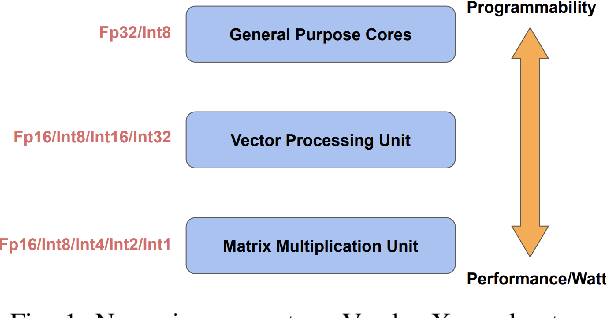
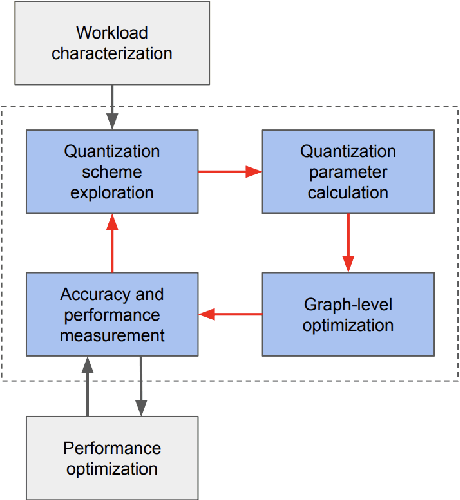
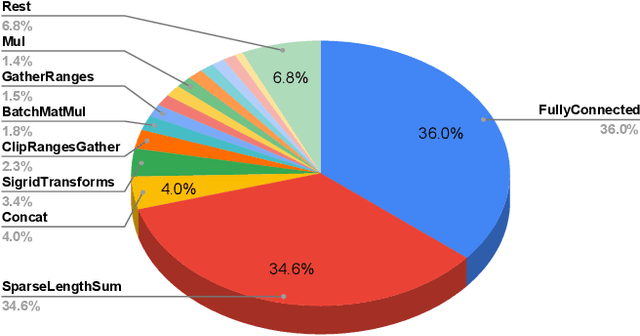
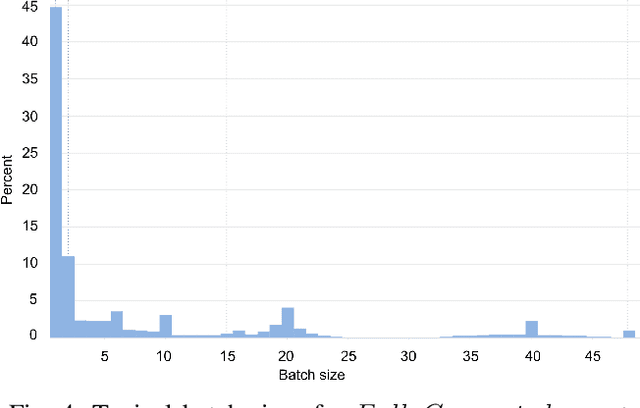
Abstract:Tremendous success of machine learning (ML) and the unabated growth in ML model complexity motivated many ML-specific designs in both CPU and accelerator architectures to speed up the model inference. While these architectures are diverse, highly optimized low-precision arithmetic is a component shared by most. Impressive compute throughputs are indeed often exhibited by these architectures on benchmark ML models. Nevertheless, production models such as recommendation systems important to Facebook's personalization services are demanding and complex: These systems must serve billions of users per month responsively with low latency while maintaining high prediction accuracy, notwithstanding computations with many tens of billions parameters per inference. Do these low-precision architectures work well with our production recommendation systems? They do. But not without significant effort. We share in this paper our search strategies to adapt reference recommendation models to low-precision hardware, our optimization of low-precision compute kernels, and the design and development of tool chain so as to maintain our models' accuracy throughout their lifespan during which topic trends and users' interests inevitably evolve. Practicing these low-precision technologies helped us save datacenter capacities while deploying models with up to 5X complexity that would otherwise not be deployed on traditional general-purpose CPUs. We believe these lessons from the trenches promote better co-design between hardware architecture and software engineering and advance the state of the art of ML in industry.
High-performance, Distributed Training of Large-scale Deep Learning Recommendation Models
Apr 15, 2021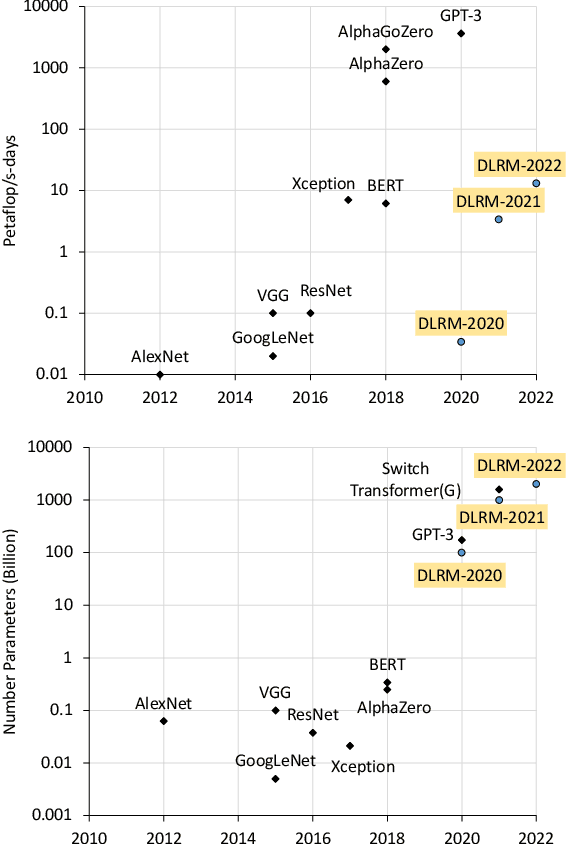
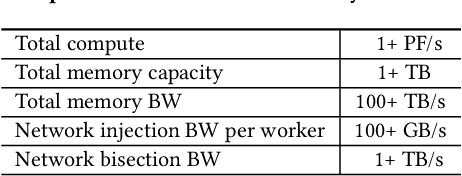
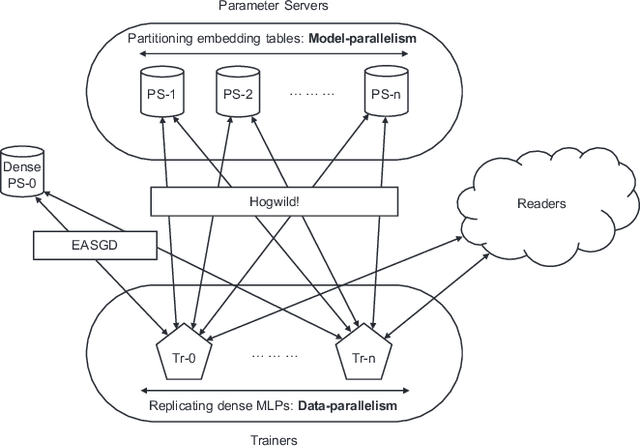
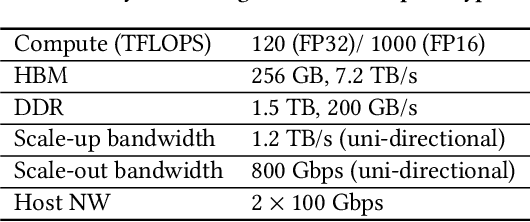
Abstract:Deep learning recommendation models (DLRMs) are used across many business-critical services at Facebook and are the single largest AI application in terms of infrastructure demand in its data-centers. In this paper we discuss the SW/HW co-designed solution for high-performance distributed training of large-scale DLRMs. We introduce a high-performance scalable software stack based on PyTorch and pair it with the new evolution of Zion platform, namely ZionEX. We demonstrate the capability to train very large DLRMs with up to 12 Trillion parameters and show that we can attain 40X speedup in terms of time to solution over previous systems. We achieve this by (i) designing the ZionEX platform with dedicated scale-out network, provisioned with high bandwidth, optimal topology and efficient transport (ii) implementing an optimized PyTorch-based training stack supporting both model and data parallelism (iii) developing sharding algorithms capable of hierarchical partitioning of the embedding tables along row, column dimensions and load balancing them across multiple workers; (iv) adding high-performance core operators while retaining flexibility to support optimizers with fully deterministic updates (v) leveraging reduced precision communications, multi-level memory hierarchy (HBM+DDR+SSD) and pipelining. Furthermore, we develop and briefly comment on distributed data ingestion and other supporting services that are required for the robust and efficient end-to-end training in production environments.
FBGEMM: Enabling High-Performance Low-Precision Deep Learning Inference
Jan 13, 2021



Abstract:Deep learning models typically use single-precision (FP32) floating point data types for representing activations and weights, but a slew of recent research work has shown that computations with reduced-precision data types (FP16, 16-bit integers, 8-bit integers or even 4- or 2-bit integers) are enough to achieve same accuracy as FP32 and are much more efficient. Therefore, we designed fbgemm, a high-performance kernel library, from ground up to perform high-performance quantized inference on current generation CPUs. fbgemm achieves efficiency by fusing common quantization operations with a high-performance gemm implementation and by shape- and size-specific kernel code generation at runtime. The library has been deployed at Facebook, where it delivers greater than 2x performance gains with respect to our current production baseline.
Mixed-Precision Embedding Using a Cache
Oct 23, 2020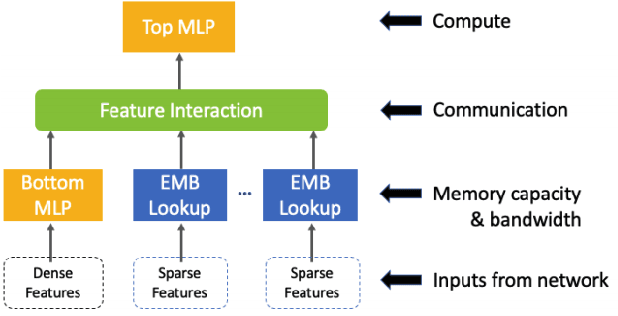
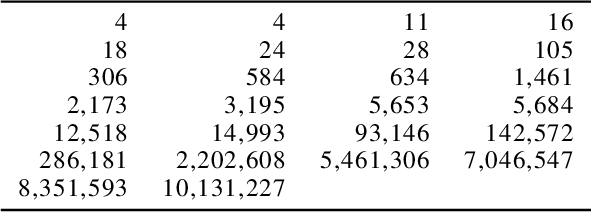
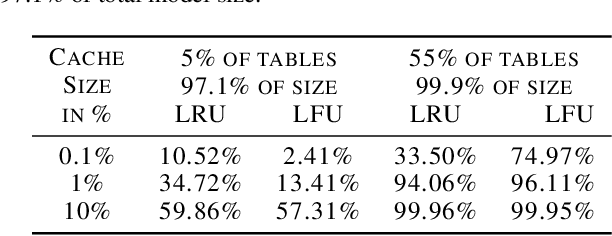
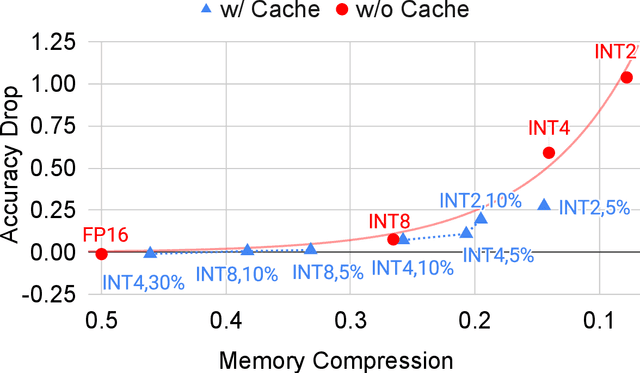
Abstract:In recommendation systems, practitioners observed that increase in the number of embedding tables and their sizes often leads to significant improvement in model performances. Given this and the business importance of these models to major internet companies, embedding tables for personalization tasks have grown to terabyte scale and continue to grow at a significant rate. Meanwhile, these large-scale models are often trained with GPUs where high-performance memory is a scarce resource, thus motivating numerous work on embedding table compression during training. We propose a novel change to embedding tables using a cache memory architecture, where the majority of rows in an embedding is trained in low precision, and the most frequently or recently accessed rows cached and trained in full precision. The proposed architectural change works in conjunction with standard precision reduction and computer arithmetic techniques such as quantization and stochastic rounding. For an open source deep learning recommendation model (DLRM) running with Criteo-Kaggle dataset, we achieve 3x memory reduction with INT8 precision embedding tables and full-precision cache whose size are 5% of the embedding tables, while maintaining accuracy. For an industrial scale model and dataset, we achieve even higher >7x memory reduction with INT4 precision and cache size 1% of embedding tables, while maintaining accuracy, and 16% end-to-end training speedup by reducing GPU-to-host data transfers.
A Study of BFLOAT16 for Deep Learning Training
Jun 13, 2019



Abstract:This paper presents the first comprehensive empirical study demonstrating the efficacy of the Brain Floating Point (BFLOAT16) half-precision format for Deep Learning training across image classification, speech recognition, language modeling, generative networks and industrial recommendation systems. BFLOAT16 is attractive for Deep Learning training for two reasons: the range of values it can represent is the same as that of IEEE 754 floating-point format (FP32) and conversion to/from FP32 is simple. Maintaining the same range as FP32 is important to ensure that no hyper-parameter tuning is required for convergence; e.g., IEEE 754 compliant half-precision floating point (FP16) requires hyper-parameter tuning. In this paper, we discuss the flow of tensors and various key operations in mixed precision training, and delve into details of operations, such as the rounding modes for converting FP32 tensors to BFLOAT16. We have implemented a method to emulate BFLOAT16 operations in Tensorflow, Caffe2, IntelCaffe, and Neon for our experiments. Our results show that deep learning training using BFLOAT16 tensors achieves the same state-of-the-art (SOTA) results across domains as FP32 tensors in the same number of iterations and with no changes to hyper-parameters.
Deep Learning Recommendation Model for Personalization and Recommendation Systems
May 31, 2019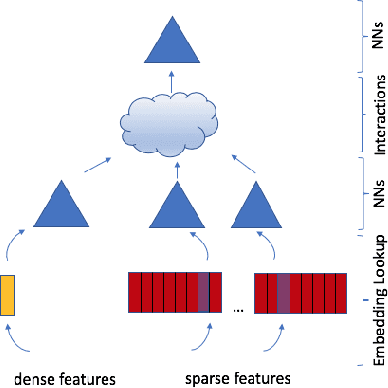

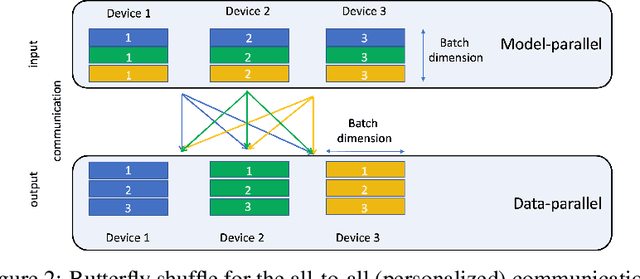

Abstract:With the advent of deep learning, neural network-based recommendation models have emerged as an important tool for tackling personalization and recommendation tasks. These networks differ significantly from other deep learning networks due to their need to handle categorical features and are not well studied or understood. In this paper, we develop a state-of-the-art deep learning recommendation model (DLRM) and provide its implementation in both PyTorch and Caffe2 frameworks. In addition, we design a specialized parallelization scheme utilizing model parallelism on the embedding tables to mitigate memory constraints while exploiting data parallelism to scale-out compute from the fully-connected layers. We compare DLRM against existing recommendation models and characterize its performance on the Big Basin AI platform, demonstrating its usefulness as a benchmark for future algorithmic experimentation and system co-design.
 Add to Chrome
Add to Chrome Add to Firefox
Add to Firefox Add to Edge
Add to Edge